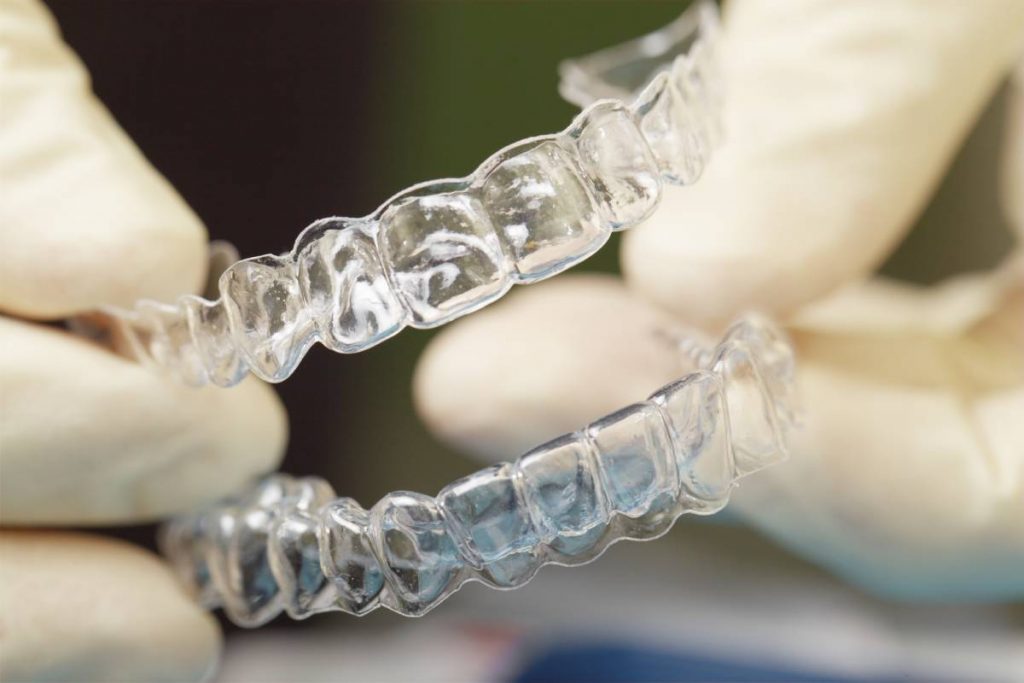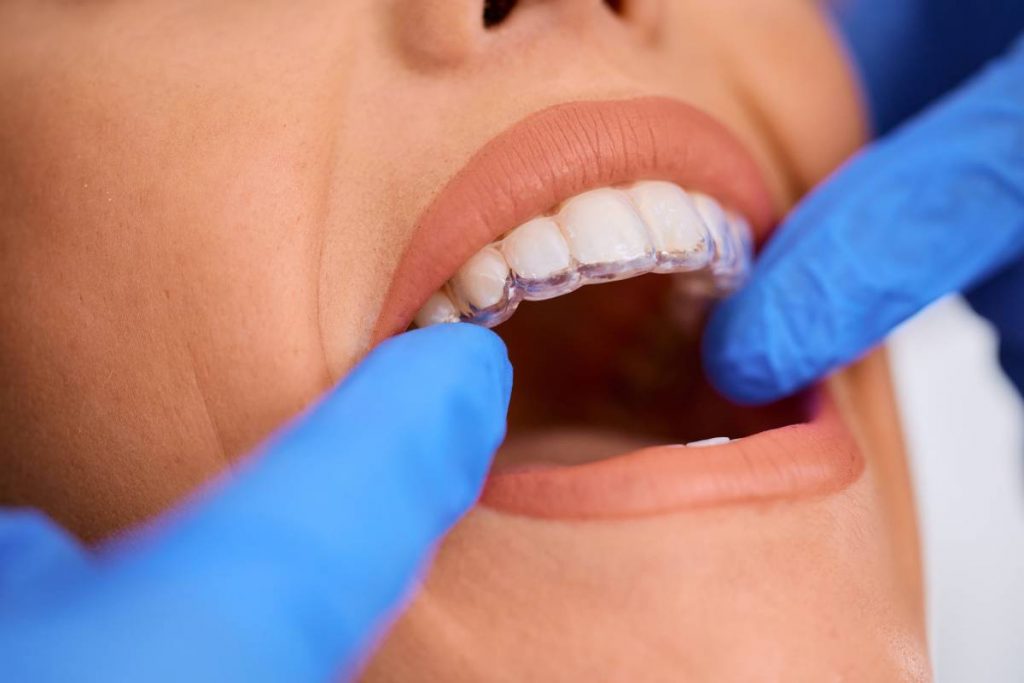Invisalign has become a favoured choice over traditional braces because it utilizes clear aligners, offering a more discreet option compared to metal braces. Since the introduction of these transparent aligners, almost half a million individuals have opted for Invisalign to align their teeth.
However, a common inquiry dentists receive from patients is: what’s the price tag on these aligners?
But first, let’s get to know what exactly is Invisalign.
More interesting article:
What is Invisalign?
Invisalign is a type of orthodontic treatment that uses clear, removable aligners to straighten teeth. These aligners are custom-made for each patient based on their individual dental impressions and treatment plan. Invisalign gradually shifts the teeth into their desired positions, providing a discreet and convenient alternative to traditional braces. It’s a popular choice for individuals seeking a more aesthetic option for orthodontic treatment.

How many types of Invisalign?
Invisalign offers several types of treatment options tailored to meet the diverse needs and preferences of patients. The primary types of Invisalign include:
- Invisalign Full:
- This is the most comprehensive Invisalign treatment, suitable for addressing a wide range of orthodontic issues, including mild to severe misalignment. It involves a series of custom-made aligners that gradually shift the teeth into their desired position.
- Invisalign Lite:
- Invisalign Lite is designed for less complex cases of misalignment, typically requiring fewer aligners and a shorter treatment duration compared to Invisalign Full. It’s an ideal option for patients with mild to moderate orthodontic concerns.
- Invisalign Express:
- Invisalign Express is intended for minor orthodontic issues, such as slight crowding or spacing irregularities. It involves a shortened treatment timeline and fewer aligners, making it a cost-effective and efficient option for minor adjustments.
- Invisalign Teen:
- Specifically tailored for teenage patients, Invisalign Teen addresses the unique orthodontic needs and lifestyle preferences of adolescents. It features special design elements, such as compliance indicators and eruption tabs, to accommodate growing teeth and ensure treatment adherence.
- Invisalign First:
- Invisalign First is designed for children with early orthodontic problems, such as dental arch expansion or teeth alignment issues. It aims to intercept orthodontic issues at an early age, potentially reducing the need for more extensive treatment in the future.
Each type of Invisalign treatment offers distinct advantages and is customized to address specific orthodontic concerns. Orthodontists work closely with patients to determine the most suitable Invisalign option based on their individual needs, treatment goals, and budget considerations.

So how much does Invisalign cost?
In Australia, the price typically falls between $6000 and $9000, but it might start from as low as $1800. The total cost varies based on your specific treatment plan, tailored to achieve your desired results.
Regarding private health insurance, if your plan covers orthodontic treatment, it should extend to Invisalign similar to traditional braces. However, it’s best to confirm this directly with your insurance provider, as coverage can vary between policies.
Is Invisalign worth it? Absolutely! If you’re hesitant about braces and the hassle they bring, Invisalign offers a convenient alternative. The aligners are removable, granting you the freedom to eat without restrictions and attend events without worrying about braces. Users often find them more comfortable than traditional braces, thanks to their gentle approach in shifting teeth.
Cleaning Invisalign aligners is a breeze, and since you get a new set every two weeks, they’re hygienic too. Plus, each aligner is custom-made using advanced 3D technology, ensuring a perfect fit and enhancing overall comfort throughout the treatment process.

Why is Invisalign so expensive?
As you can see, Invisalign is so expensive, like traditional braces are expensive enough but Invisalign is going to another level. What makes it so expensive? Let’s find out.
- Material Costs:
- Traditional braces are typically made from metal brackets and wires, which are relatively inexpensive materials.
- In contrast, Invisalign employs advanced technology, using clear, medical-grade plastic aligners custom-made for each patient. The production of these aligners involves precise 3D printing and sophisticated materials, contributing to higher manufacturing costs.
- Complexity of Treatment:
- Invisalign is often preferred for less severe cases of misalignment or for those who desire a more discreet option. However, complex cases may require additional aligners and treatment time, which can escalate the overall cost.
- Traditional braces are versatile and can address a wide range of orthodontic issues, from simple to complex, without significantly altering the cost.
- Labor and Expertise:
- Both Invisalign and traditional braces require professional expertise for installation and monitoring throughout the treatment process.
- Invisalign treatment involves careful planning by orthodontists, who design a custom treatment plan using computer software. Additionally, frequent check-ins are necessary to ensure the aligners are working effectively.
- Traditional braces demand regular adjustments and maintenance by orthodontic specialists to ensure proper alignment. Although the materials are less costly, the expertise required for installation and ongoing care contributes to the overall expense.
- Aesthetics and Comfort:
- Invisalign aligners are virtually invisible, offering a discreet option that appeals to many patients, especially adults and teenagers concerned about the appearance of traditional braces.
- Traditional braces, while effective, are more conspicuous and may cause discomfort due to wires and brackets rubbing against the cheeks and gums. Some patients may opt for Invisalign solely for the added comfort and aesthetic benefits, willing to pay a premium for these features.
- Insurance Coverage and Market Demand:
- Insurance coverage for orthodontic treatment varies widely, with some plans offering partial or full coverage for either Invisalign or traditional braces.
- Market demand also plays a role in pricing. Invisalign’s popularity has surged in recent years due to its discreet nature and convenience, allowing manufacturers to set higher prices based on consumer willingness to pay.
The cost disparity between Invisalign and traditional braces can be attributed to factors such as material quality, treatment complexity, labour, aesthetics, and market demand. While Invisalign may be pricier upfront, many patients find the benefits, including comfort and aesthetics, well worth the investment.
However, it’s essential to consult with an orthodontic specialist to determine the most suitable option based on individual needs and budget constraints.
Final note
The cost of Invisalign braces varies, but they’re generally not significantly more expensive than regular braces. It’s important to weigh the benefits they offer compared to traditional braces.
Invisalign aligners are removable, allowing you to take them out when eating or brushing your teeth, which simplifies dealing with braces. Plus, they’re mostly clear, making them less noticeable and reducing the urge to hide your smile.
Ultimately, the best option for you depends on your teeth’s current position and alignment needs. Invisalign aligners may offer a more comfortable way to straighten your teeth, especially if you’re concerned about the appearance of metal braces.
The next step is to reach out to your dentist to learn more about Invisalign and determine if it’s right for you. The knowledgeable staff can address any questions you have about Invisalign, and some dental clinics even offer free consultations to explore your options further.





